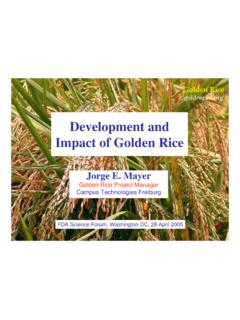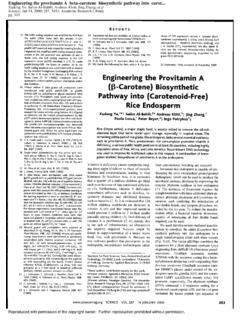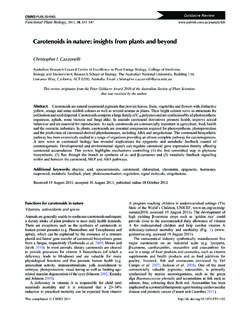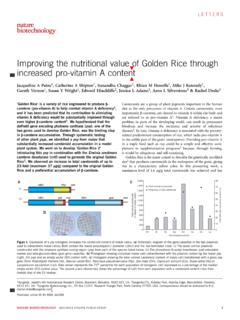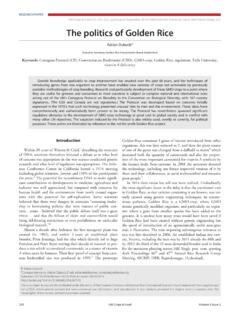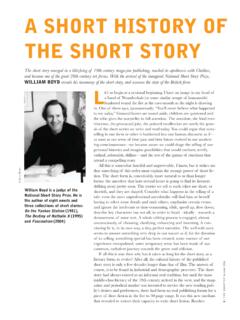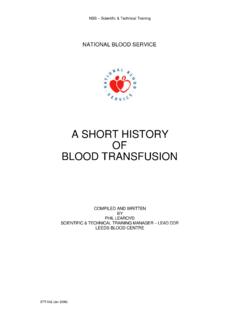Transcription of Breeding history - The Golden Rice Project
1 Forty years ago, a remarkable rice- Breeding Project culminated in the release of a rice variety under an unremarkable name IR8. This is the story of the research that would ultimately change the face of agriculture across historyAsia was desperate for food after World War II. Only massive shipments of grain prevented famine. Rice was, and is, Asia s lifeblood. That s why the Ford and Rockefeller foundations pooled resources and, in 1960, established a modern research center to focus on the world s most important crop: the International Rice Research Institute (IRRI), based in Los Ba os, Philippines. Robert Chandler, IRRI s fi rst director, assembled a team with a mission: to develop a high-yielding rice variety. IRRI scientists knew that the architecture of the tropical rice plant was the main constraint to yield increases.
2 Traditional rice varieties are tall, with long, weak stems. When a farmer fertilizes a tall plant, it lodges, or falls over. Photosynthesis ceases, and grain rots in the water, or rats eat short, nonlodging rice plant that would convert nutrients to grain and hold the panicle (the terminal shoot of the rice plant that produces grain) upright a dwarf or semidwarf was needed to accelerate rice production. IRRI didn t invent the dwarf concept. Scientists had already established it in other crops. Dwarf sorghum was already available. And semidwarf rice varieties PRESIDENT Lyndon B. Johnson makes an impassioned speech during his October 1966 visit to IRRI. He said, If we are to win our war against poverty, and against disease, and against ignorance, and against illiteracy, and against hungry stomachs, then we have got to succeed in projects like this, and you are pointing the way for all of Asia to follow.
3 Examin-ing IR8 in the Institute fi elds in August 1967 are IRRI breeder Hank Beachell (crouching), visiting philanthropist John D. Rockefeller III (left), and IRRI Director Robert Chandler. IRRI breeder Peter Jennings briefs visitors on IR8 in April 1966, only 7 months before its offi cial release (inset). URBITO ONGLEO (3)IRRI by Tom Hargrove and W. Ronnie Coffman 3534 Rice Today October-December 200636 Rice Today October-December 2006had already been developed and released in mainland China, largely unknown to the rest of the significant, in 1946, Salmon, a geneticist with General Douglas MacArthur s Occupation Army in Japan, had sent seeds of Norin 10, a dwarf wheat variety that he found in a Japanese agricultural experiment station, to Orville Vogel at Washington State University.
4 Within a few years, Dr. Vogel had developed Gaines, a semidwarf wheat variety that spread rapidly across the Pacific Northwest. Vogel sent seeds with the Norin 10 dwarfing gene to Norman Borlaug of the Rockefeller Foundation wheat program in Mexico. Dr. Borlaug used those seeds to breed semidwarf wheat varieties. The most successful was 8156 given that name for Dr. Borlaug s 8,156th cross. 8156 yielded bountifully and made Mexico self-sufficient in wheat production by the mid-1960s. Seeds of 8156 spread to Pakistan, where it was called MexiPak, then to Turkey, Iran, and 1949, the Food and Agriculture Organization of the United Nations established the International Rice Commission, which commissioned an indica-japonica hybridization Project based in Cuttack, India. Its mission was to cross the short japonica, or temperate, rice with taller indica, or tropical, varieties, to develop short-statured varieties with higher yield potential.
5 Shorter rice varieties such as ADT 27 and Mahsuri, selected from the japonica indica crosses, were widely planted across the Indian subcontinent in the , rice breeders were irradiating seeds of tall varieties, hoping to induce a short-statured mutant. Among those pioneers were Nelson Jodan of Louisiana State University s rice research center in Crowley, Louisiana, and Henry ( Hank ) Beachell of the Texas A&M University rice research center near Beaumont, Texas. But their selections had high sterility and were not 1957, the Rockefeller Foundation sent Peter Jennings, a young plant pathologist, to Arkansas, Texas, and Louisiana to learn about rice in order to develop new rice varieties for Latin America. The Rockefeller Foundation then sent Dr. Jennings to Mexico and Colombia.
6 Dr. Jennings and Sterling Wortman, later to become IRRI s associate director, traveled across Asia in 1960, looking at rice varieties, meeting rice scientists, and interviewing prospective trainees and staff. Be on the lookout for a dwarf rice, Dr. Beachell recalls advising them. Dr. Beachell visited the fledgling IRRI as a consultant in 1962, then returned to India, Drs. Jennings and Wortman encountered Taichung Native 1 (TN1), a Taiwanese variety that was probably the first widely grown semidwarf variety in the tropics. TN1 yielded far better than tall varieties, but was highly susceptible to major disease and insect pests. Dr. Jennings joined IRRI as head of the Varietal Improvement Department in 1961. Among the germplasm assembled at that time was Dee-geo-woo-gen (DGWG) from China, a parent of TN1, and clearly its source of dwarfism.
7 But at that time the nature of inheritance of DGWG s short stature was Chandler described DGWG as a high-yielding, heavy-tillering, short-statured variety from Taiwan. Dr. Jennings and Akiro Tanaka, hired from Japan as IRRI s first plant physiologist, conceptualized the semidwarf rice plant and systematically studied the causes, and effects, of lodging during IRRI s first 3 years. In his 1982 book, An adventure in applied science: a history of the International Rice Research Institute, Dr. Chandler wrote about lodging research:By supporting tall varieties such as Peta and MTU-15 with bamboo sticks, Jennings found that tall varieties yielded essentially as well as did lodging-resistant varieties. Moreover, the lodging-susceptible varieties, when supported, responded well to nitrogen applications, whereas the unsupported plants showed a decided negative response.
8 This proved beyond doubt that lodging per se was the primary cause of low yields when traditional tropical varieties were subjected to modern management Chandler made several references to IRRI s Breeding objectives in the first IRRI Annual Report (1961-62). The section Varietal Improvement almost gives a blueprint for the AFTER A BUMPER crop in his first season grow-ing IR8, Indian farmer Ganesan was so moved by the new variety that he named his second son in its honor IR-ettu in Tamil, and signed as Irettu. Here, father and son stand in a field of a different variety, IR50, in 1983. THE TALL Peta variety, one of IR8 s parents, towers over its more resilient offspring. Because of its shorter, stouter stature, IR8 was less prone to lodging (falling over), which caused severe yield losses in the taller traditional HETTELIRRI37 Rice Today October-December 2006variety, yet to be developed, that several years later would turn rice production on its head:It would seem that the following plant type might be useful in the near future through-out much of the tropics a combination of short, stiff culms bearing erect, moderately sized, dark-green leaves; responsiveness in yield to fertilizer; mid-season maturity and in most cases, photoperiod sensitivity to permit double cropping practices.
9 These objectives are being pursued [..] with both indica by indica and indica by japonica much was known about the genetics of tropical rice varieties at the time, so IRRI hired a geneticist Te Tzu Chang, from Taiwan in its first group of scientists. Dr. Chang began studying the inheritance of plant made 38 crosses in late 1962; 11 of them included the dwarf parent DGWG, TN1, or I-geo-tze (IGT) another dwarf from Taiwan. The eighth IRRI cross from which IR8 was eventually selected was of Peta, a tall, vigorous variety from Indonesia, and DGWG. From that cross, 130 seeds were formed. Those seeds were planted in pots in IRRI s screenhouse and produced the first, or F1, generation of plants. All were tall. Seeds from the F1 plants were sown in the field, and produced about 10,000 second-generation (F2) plants that segregated by height in a ratio of three talls to one dwarf.
10 Dr. Jennings immediately recognized this as a Mendelian ratio named after Gregor Mendel, who became known as the father of genetics for his 19th-century research into the inheritance of traits in pea plants. This was a key result it meant that dwarfism in DGWG was controlled by a single gene and was therefore simply inherited, making the job of developing a commercially usable semidwarf variety immeasurably easier. Dr. Jennings immediately brought Drs. Chandler and Wortman to the field to see the segregating plants. He then cabled the good news to Dr. Beachell in Texas. That s when we knew we had it [meaning that DGWG could be used to breed an improved semidwarf variety], Dr. Beachell recalled years this discovery, Dr. Jennings persuaded Drs. Chandler and Wortman to exchange a cytogenetics position in the Varietal Improvement program for a second breeder to help with the increase in field work that would obviously come.
